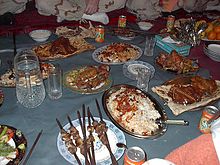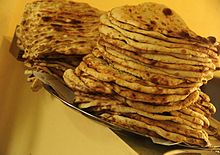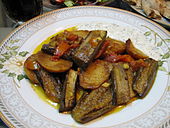- Afghan cuisine
-
 A table setting of Afghan food in Kabul
A table setting of Afghan food in Kabul
Afghan cuisine is largely based upon the nation's chief crops: cereals like wheat, maize, barley and rice. Accompanying these staples are dairy products (yogurt and whey), various nuts, and native vegetables, as well as fresh and dried fruits; Afghanistan is well known for its grapes. Afghanistan's culinary specialties reflect its ethnic and geographic diversity and has similarities with neighboring Pakistan, Iran, Turkmenistan, Uzbekistan, Tajikistan, and China.
Contents
General information
Although Afghan food may vary between regions, similarities exist. Fresh yogurt, coriander, garlic, onions, spring onion, tomatoes, potatoes, and fruit are widely available in all parts of Afghanistan and are used in preparing foods. Fruits and vegetables, fresh and dried, form an important part of the Afghan diet, especially in the rural areas. Afghanistan produces a variety of fruits, notably grapes, pomegranates, apricots, berries, and plums. These fruits have traditionally been Afghanistan's main food exports. Dried nuts and seeds, such as walnuts, pistachios, almonds, and pine nuts are both very popular and plentiful in Afghanistan. Exceptional[citation needed] varieties of oranges, known locally as "Malta" are grown in the warm climate of Nangarhar province. Olive oil is also produced in Nangarhar province but for local and national consumption only. Wardak province is well known for its delicious apples and apricots, and the same goes with Kandahar for having the best pomegranates. Herbs and spices used in Afghan cuisine include mint, saffron, coriander, cilantro, cardamom, and black pepper. Lamb and chicken are the preferred meats. Meat, especially lamb, is widely consumed. Afghan cuisine emphasizes well-balanced tastes. Food should be seasoned but neither too spicy nor too bland. Contrasts are emphasized.
Kabul influence on Afghan cuisine
Kabul, the capital of Afghanistan, is a multi-ethnic city and has always been so. As the seat of government for the Afghan kings, food was an important part of royal life. Chefs were commissioned from all over the empire and places afar. They are credited for creating myriad dishes, blending different styles and in the process creating the best examples of true Afghan cooking. Their creations include exotic qormas, palaos, sumptuous rice dishes, desserts, and other creative items. These royal chefs passed down their art to the aristocratic denizens of Kabul and they in turn to others. Several attempts were made to record the arts of the royal chefs. Two have been published. The first one, published in Afghanistan in the early 1900s recorded the ingredients and cooking styles of Afghanistan's monarchy. The second, called Aushpazi, by Wali Zikria, published in the United States in English, during the early 1990s, was essentially the cookbook of one of Afghanistan's royal houses.
Dastakhan
Known as the dastarkhan or sofrah, the floor spread is an important expression of culture in Afghanistan. Regardless of economic status, creating an adequate dastarkhan is important to any family, especially when having guests. A large cloth will most likely be spread over a traditional rug in the living area or on a formal dining table. Most likely a young member of the family will present a "aftabah wa lagan", a copper basin and elaborate pot filled with water for the household to wash their hands in. He or she will go around the destarkhan to each member, pour water over the hands. Soap is provided, as is a drying cloth. The destarkhan is then dutifully filled with breads, accompaniments, relishes, appetizers, main courses, salads, rice, and fruits. Arrangement of foods is important when having guests; they must have easy access to the specialty foods. Young girls are taught how to spread a good destarkhan and will be busy helping the women.
Breads and accompaniment
There are mainly three types of Afghan bread:
- Naan - Literally "bread". Thin, long and oval shaped, its mainly a white/whole wheat blend. Topped with poppy seeds, sesame seeds, nigella seeds, or some combination of these. Upon request, customers may be able to get all white flour and a helping of oil, which makes it rich and delicious.
- Obi Non - Uzbek-style bread. Shaped like a disc and thicker than naan. Usually made with white flour.
- Lavash - Very thin bread. Similar to the Lavash elsewhere. Usually used as plating for meats and stews.
Accompaniments may include:
- Torshi - Various pickled fruits (i.e., peache, lemon) and vegetables (eggplant, garlic) mixed with vinegar and spices.
- Chatney - Pepper sauces. Usually made with vinegar, fresh cilantro, chili peppers, and sometimes tomato paste.
Rice dishes
Rice dishes are the "king" of all foods in Afghanistan. The Afghans have certainly taken much time and effort in creating their rice dishes, as they are considered the best part of any meal. Wealthier families will eat one rice dish per day. The Afghan royalty spent much time on rice preparation and invention as evidenced in the sheer number of rice dishes in their cookbooks. Weddings and family gatherings must feature several rice dishes and certainly reputations can be made in the realm of rice preparation. The types of rice prepared are outlined below.
Chalao
White rice. Extra long grains such as Basmati is required. First parboiled, then drained, and finally baked in an oven with some oil, butter, and salt. This method creates a fluffy rice with each grain separated, unlike Chinese or Japanese rice. Chalao is served mainly with qormas (korma; stews or casseroles)
Palao
 Afghan style eating with plates of Palao dishes lined up.
Afghan style eating with plates of Palao dishes lined up.
Cooked the same as chalao, but either meat & stock, qorma, herbs, or a combination are blended in before the baking process. This creates elaborate colors, flavors, and aromas for which some rices are named after. Caramelized sugar is also sometimes used to give the rice a rich brown color.Examples include:
- Palao - The national dish, meat and stock added, topped with fried raisins, slivered carrots, pistachios.
- Yakhni Palao - meat & stock added. Creates a brown rice
- Zamarod Palao - Spinach qorma mixed in before the baking process, hence 'zamarod' or emerald.
- Qorma Palao - Qorm'eh Albokhara wa Dalnakhod mixed in before the baking process
- Bore Palao - Qorm'eh Lawand added. Creates a yellow rice.
- Bonjan-e-Roomi Palao - Qorm'eh Bonjan-e-Roomi (tomato qorma) added at baking process. Creates a red rice.
- Serkah Palao - Similar to yakhni palao, but with vinegar and other spices.
- Shebet Palao - Fresh dill, raisins added at baking process.
- Narenj Palao - A sweet and elaborate rice dish made with saffron, orange peel, pistachios, almonds and chicken.
- Maash Palao - A sweet and sour palao baked with mung beans, apricots, and Bulgur (a kind of wheat). Exclusively vegetarian.
- Alou Balou Palao - Sweet rice dish with cherries and chicken.
Sticky Rices
Boiled medium grain rice cooked with its meat, herbs, and grains. Because the water is not drained, it forms a sticky rice texture. Notable dishes include Mastawa, Kecheri Qoroot, and Shola. When white rice is cooked to a sticky consistency it is called bata, and is usually eaten with a qorma, such as Sabzi (spinach) or Shalgham (turnips). A sweet rice dish called Shir Birenj (literally milk rice) is often served as desert.
Qorma
Qorma is a stew or casserole, usually served with chawol. Most qormas are onion-based. Onions are fried, then meat is added, as are a variety of fruits, spices, and vegetables depending on the recipe. Finally water is added and left to simmer. The onion caramelizes and creates a richly colored stew. There exist over 100 qormas. Below are some examples.
- Qorma Alou-Bokhara wa Dalnakhod - onion based, with sour plums, lentils, and cardamom. Veal or chicken.
- Qorma Nadroo - onion based, with yogurt, lotus roots, cilantro, and coriander. Lamb or veal.
- Qorma Lawand - onion based, with yogurt, turmeric, and cilantro. Chicken, lamb, or beef.
- Qorma Sabzi - sauteed spinach and other greens. Lamb
- Qorma Shalgham - onion based, with turnips, sugar; sweet and sour taste. Lamb.
Pasta
Pasta is called "khameerbob" in Afghanistan and is often in the shape of dumplings. These native dishes are wildly popular. Due to the time-consuming process of creating the dough for the dumplings, it is rarely served at large gatherings such as weddings, but for more special occasions at home:
- Mantu - A dish of Uzbek origin. Dumplings filled with onion & ground beef. Mantu is steamed and usually topped with a tomato-based sauce and a yogurt or qoroot-based sauce. The yogurt-based topping is usually a mixture of yogurt, sour cream, and garlic. The qoroot based sauce is made of goat cheese and is also mixed with garlic. Sometimes a qoroot and yogurt mixture will be used. The dish is then topped with dried mint.
- Ashak - Kabul dish. Dumplings filled with leeks. Boiled and then drained. Ashak is topped with garlic-mint qoroot or a garlic yogurt sauce and a well seasoned ground meat mixture.
Each family or village will have its own version of mantu and ashak, which creates a wide variety of dumplings.
Pasta in the form of noodles is also commonly found in aush, a noodle soup served in several varieties around the country.
Kebab
Afghan kebab is most often found in restaurants and outdoor vendor stalls. Sometimes they are put into shishas. Families rarely serve homemade kebab in their home due to the need of inaccessible equipment. The most widely used meat is lamb. Recipes differ with every restaurant, but Afghan kebab is usually marinated with a blend of spices, and served with naan, rarely rice. Customers have the option to sprinkle sumac, locally known as ghora, on their kebab. The quality of kebab is solely dependent on the quality of the meat. Pieces of fat from the sheep's tail (jijeq) are usually added with the lamb skewers to add extra flavor.
Other popular kebabs include lamb chops, ribs, kofta (ground beef) and chicken; all of which are found in better restaurants.
Chapli kebab, a specialty of eastern Afghanistan, is a fried hamburger. The original recipe of chapli kebab dictates a half meat (or less), half flour mixture, which renders it lighter in taste, and less expensive.
Afghan food items
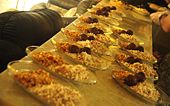 Rice with kofta (meat balls) and corn
Rice with kofta (meat balls) and corn
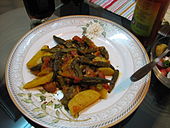 Baamiyah (Okra), also served as a side dish.
Baamiyah (Okra), also served as a side dish.
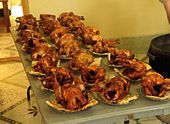 Roasted chicken kebab
Roasted chicken kebab
- Afghan Kufta
- Afghan Kadu Bouranee (Sweet Pumpkins)
- Ashak (vegetable and chive-filled dumplings topped with tomato and yogurt sauces)
- Aush (hand made Noodles)
- Bichak (small turnovers with various fillings, including potato and herbs, or ground meat)
- Shorwa (Afghan soup) similar to borscht
- Dolma (Stuffed grape leaves)
- Londi, or gusht-e-qaaq (spiced jerky)
- Kichiri (sticky medium grain rice cooked with mung beans and onions)
- Badenjan (Cooked eggplant w/potatoes and tomatoes)
- Badenjan-Burani (fried slices of eggplant, topped with a garlic sour cream sauce, and sprinkled with dried mint)
- Baamiyah (okra)
- Bolawnee/Bolani (Afghan bread/pancakes)
- Quroot (dried yogurt cheese)
- Halwaua-e-Aurd-e-Sujee
- Nan-e-Afghan/Nan-e-Tandoori (Afghan bread cooked in a vertical in ground clay oven, or a tandoor)
- Nan-e-Tawagy (Flat bread cooked on a flat pan)
- Osh Pyozee (Stuffed onions)
- Mantu (Meat dumplings) usually served under a yogurt-based white sauce.
- Qabili Palau (Traditional rice dish)
- Dampukht (Steamed Rice)
- Bonjan Salad (Spicy eggplant salad)
- Shor-Nakhud (Chick peas with special toppings)
- Maast or labanyat (type of plain yogurt)
- Chakida or chakka (type of sour cream)
- Salata (tomato and onion based salad, often incorporating cucumber)
- Sheer Berinj (Rice pudding)
- Cream roll (pastries)
- Baklava (Pastry)
- Afghan Cake (similar to pound cake sometimes with real fruit or jelly inside)
- Gosh Feel (thin, fried Pastries covered in powdered sugar and ground pistachios)
- Kebabs (similar to Middle Eastern style)
- Fernea (Milk and cornstarch very sweet, similar to rice pudding without the rice)
- Mou-rubba (fruit sauce, sugar syrup and fruits, Apples, Sour Cherry, various berries or made with dried fruits "Afghan favorite is the Alu-Bakhara")
- Kulcha (Variety of cookies, baked in clay ovens with char-wood)
- Narenge Palau (dried sweet orange peel and green raisins with a variety of nuts mixed with yellow rice glazed with light sugar syrup)
- Nargis kabob (Egg based angel hair pasta soaked in sugar syrup wrapped around a piece of meat)
- Torshi (Eggplant and Carrot mix with other herbs and spices pickled in vinegar aged to perfection)
- Khoujoor (Afghan pastry deep fried, oval shaped, similar to doughnuts taste wise)
- Kalah Chuquki or Kalah Gunjeshk (battered deep fried bird heads)
- Kalah Pacha (Lamb or Beef head/feet cooked in a broth served in bowls as a soup dish or in a stew or curry style)
- Shami kabob (Cooked beef meat blended with spices and flour and eggs and rolled in hot dog shapes or flat round shape and fried)
- Chopan kabob (Lamb Chops, skewered and grilled on charcoal)
- Delda or Oagra (mainly a Southern dish made from the main ingredient of split wheat and a variety of beans mixed)
- Owmach (made from flour, soup-like dish, very thick and pasty)
- Peyawa or Eshkana (a soup, based on flour very similar to a gravy but mixed with chopped onions, potatoes and eggs.
- Aushe Sarka (Vinegar-based flat noodle soup, taste very similar to Chinese hot & sour soup minus the Chinese ingredients)
- Maushawa (Mixed beans and tiny meat balls, served in a bowl)
See also
- Pashtun cuisine
References
External links
- The Spice Spoon (Afghan/Pakistani food blog)
- Afghan cooking, recipes and culture
- Afghani Foods and Cuisine
- Afghan Food and Cookery
- Afghan cooking
- Afghan food recipes from AsiaRecipe.com
- Some Afghan Dishes
Asian cuisine Sovereign
states- Afghanistan
- Armenia
- Azerbaijan
- Bahrain
- Bangladesh
- Bhutan
- Brunei
- Burma (Myanmar)
- Cambodia
- People's Republic of China
- Cyprus
- East Timor (Timor-Leste)
- Egypt
- Georgia
- India
- Indonesia
- Iran
- Iraq
- Israel
- Japan
- Jordan
- Kazakhstan
- North Korea
- South Korea
- Kuwait
- Kyrgyzstan
- Laos
- Lebanon
- Malaysia
- Maldives
- Mongolia
- Nepal
- Oman
- Pakistan
- Philippines
- Qatar
- Russia
- Saudi Arabia
- Singapore
- Sri Lanka
- Syria
- Tajikistan
- Thailand
- Turkey
- Turkmenistan
- United Arab Emirates
- Uzbekistan
- Vietnam
- Yemen
States with limited
recognition- Abkhazia
- Nagorno-Karabakh
- Northern Cyprus
- Palestine
- Republic of China (Taiwan)
- South Ossetia
Dependencies and
other territoriesCategories:- Afghan cuisine
- Pashtun cuisine
Wikimedia Foundation. 2010.

